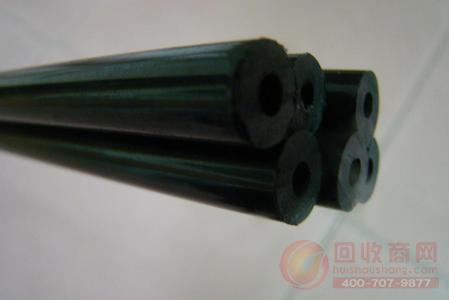Those factors will have an important impact on the quality of hard pipe products.

Single-screw extruders often use plasticized pellets to form hard tubes. Therefore, the quality of hard tube products is largely determined by the degree of plasticization and uniformity of the semi-product pellets.
There are two kinds of plasticizing process routes for pellets: one is to plasticize the kneaded uniform powder in the extruder, and then cut the round bar by rotating the file while releasing the round bar on the machine head. Pellet
The other is that the kneaded material is plasticized on a compacting and rolling machine, and then drawn into a piece of a certain thickness and a certain width, rolled into a roll, and then granulated into square pieces.
1. Extrusion plasticizing granulation
The advantages are continuous sealing, low equipment investment, low labor intensity and low noise, so it is the development trend of the current granulation process. The special twin-screw granulating extruder has received widespread attention due to its good mixing degree and uniform plasticization.
However, the following points must be paid attention to in the production: the raw materials must have sufficient fineness to ensure uniform mixing in the kneader, otherwise the particles will have a white point of tribasic lead sulfate in the process of extrusion granulation. The carbon black spots, and the agglomerates of the fillers affect the quality.
The resin must be selected from loose (ie cotton ball) resin to avoid affecting the continuous mashing of the granulating extruder.
The temperature of the extruder body must be controlled below 170 ° C to avoid discoloration of the outside of the pellets and micropores inside. Such pellets are unstable in the production of pipes and are easily decomposed.
During the granulation process, the filter must be exchanged frequently to avoid mixing of the waste, or to disrupt normal operations due to the mesh being penetrated.
2, mixing rolling plasticizing granulation
The temperature of the mixing and plasticizing and the plasticizing of the drum should not be too high, the temperature of the dense plasticizing material should not exceed 175-180 ° C, and the spacing of the plasticizing of the drum should not exceed 3 mm. The process of low temperature and multi-turning is comparatively reasonable. At the same time, each batch of pellets requires a uniform degree of plasticization.
It is described as follows: The raw materials must be uniformly mixed during the mixing process. Otherwise, the tribasic lead sulfate and barium stearate are easily precipitated during the extrusion process, and the stability of the pellets is poor and easy to decompose.
In the process of mixing and plasticizing, if the temperature of the material is too high, the tube will be easily hairy and foamed during the extrusion process.
When using a two-pass rolling plasticizing production of pellets without using an internal mixer, it should be noted that the plasticizing temperature should not be too low, otherwise the tube may be brittle, and the flat test may not meet the quality requirements.
The plasticizing temperature is too high, and during the extrusion process, the pressure is large and the main motor current is increased.
Beautiful: The back to wall Smart Toilet with hidden water tank design creates a clean and simple bathroom space. The absence of a visible tank gives the toilet a sleek, streamlined look that enhances the overall aesthetic of the space.
Easy to clean and maintain: With no exposed tank, cleaning the back-to-wall smart toilet just got easier. There are no nooks and crannies where dirt or dust can collect, making it easier to wipe and keep clean. Plus, the hidden tank is easily accessible when repairs or maintenance are required, saving time and effort.
Additional Features: The wall-mounted smart toilet is equipped with a range of advanced features for enhanced functionality and comfort. These may include self-cleaning systems, automatic deodorization, automatic flushing, bidet cleaning functions, and even night lights. These features provide additional comfort and convenience to the user.
Water efficiency and sustainability: Smart toilets feature water-saving technologies such as dual flush systems or high-efficiency flush mechanisms. This helps conserve water and promotes sustainable living. By reducing water usage, the back-to-wall smart toilet helps the environment.
In conclusion, the wall-mounted smart toilet has both aesthetic and functional advantages. Its hidden cistern design brings a clean, modern look to the bathroom, while also making cleaning and maintenance easier. Additional features enhance comfort and convenience, and a focus on water efficiency aligns with sustainable living practices. Overall, the wall-mounted smart toilet provides a comfortable, stylish and eco-friendly toileting experience.
Back To Wall Smart Toilet, Dual Flush Smart Toilet, Intelligent Water Closet, Hidden Cistern Toilet
Guangdong Fabia Intelligent Technology Co., Ltd , https://www.fabiaintelligent.com